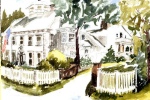GILLETTE CASTLE STATE PARK
It looks like a medieval fortress, but a step inside the stone castle reveals the built-in couches, table trackway, and woodcarvings that all point to the creative genius that was William Gillette.
The Castle is open from 10:00 a.m. to 4:30 p.m., Memorial Day Weekend through Columbus Day. Staff are available to assist with questions about the Castle interior and its history.
The newly refurbished Gillette Castle State Park is an excellent locale to examine the Hebron formation, consisting of gneiss and pegmatite intrusions. Although individual trails are not marked, the spaghetti bowl setting lends nicely to exploration of the Hebron formation, the only rock formation within the Park. The coarse grained pegmatites, a member of the Hebron formation, are especially interesting to mineral lovers, as many diverse minerals can be observed throughout these pegmatites.
The Hebron formation consists of a calcite and quartz-rich gneiss. A metamorphic rock, gneiss (pronounced "nice") was subjected to intense heat and pressure during formation. Gneiss is easily identifiable by the segregation of light and dark minerals giving it a banded texture. Gneiss usually consists of mostly elongated and granular, as opposed to platy, minerals. At Gillette Castle State Park, the gneiss is layered and is greenish-gray in color, due in part to the green mineral diopside. In addition to diopside, quartz, plagioclase, and biotite are minerals associated with the Hebron Gneiss.Photograph of shale-like Hebron Gneiss outcrop with hammer for scaleThe Hebron Gneiss at Gillette Castle State Park is very well layered. However, the thickness of these layers varies from outcrop to outcrop. For example, some outcrops are very thickly bedded, whereas others are almost shale-like in theirthickness.
Pegmatites in the Hebron formation typically are white or light-gray rocks containing reddish brown biotite, tourmaline, and garnet as accessory minerals. Pegmatite is an igneous rock that formed from molten rock buried deep below the surface of the Earth. Since the molten rock was well insulated beneath the surface it cooled very slowly, allowing the crystals to grow very large. The pegmatite crystals of the Hebron formation are approximately 3 cm in length. Generally small, pegmatite intrusions usually have the same composition as granite, only coarser. Furthermore, pegmatite intrusions are of great interest to mineral collectors because they may contain a variety of rare minerals. One mineral of interest, black tourmaline, is abundant near the contacts, in small prisms lying parallel to the contact surface. Since this is a State Park, mineral and rock collecting is prohibited.
Given that Gillette Castle State Park is located only a few miles away from the Honey Hill fault, a very large, old fault, much of the pegmatite is in the shape of lenses and layers and shows distinct pinch-and-swell structures, known as boudinage. Boudinage, which is French for sausage, is a term used to describe the way that layered rocks break up under extensional stress (Figure 5a and 5b). In addition to boudinage, other structural geology features seen at Gillette Castle State Park include folds and a drag fault (Figure 5c). Small-scale features such as small folds and faults are younger than the deformation that produced the laminar gneisses. The steps leading up to the Castle's main entrance are of another rock type, schist. Like gneiss, schist is a metamorphic rock that has undergone intense heat, pressure, and hot fluids. By definition, schist contains more than 50% platy and elongate minerals such as mica and amphibole. This high percentage of platy minerals allows schist to be easily split into thin flakes or slabs. This particular schist has a very high concentration of white mica, giving it a vitreous, or shiny, nature. In addition to white mica, glassy, red garnet crystals up to 5 mm in diameter are clearly visible in the steps as well. The garnets are special not only because they are so large, but also since they are euhedral, meaning that their ideal crystal shape is nearly perfect. In addition, they are the Connecticut state mineral. The new visitor center has similar schist with garnets in its steps.
Atop the most southerly hill in a chain known as the Seven Sisters, William Hooker Gillette, noted actor, director, and playwright, built this one hundred and eighty-four acre estate, the Seventh Sister. The focal point of his effort was a twenty four room mansion reminiscent of a medieval castle.
Purchased by the State of Connecticut in 1943 from the executors of Mr. Gillette's will, Gillette Castle and the adjoining property with its fine woodlands, trails, and vistas are now administered for the enjoyment of present and future generations. This apparently would have pleased Gillette, since his will gave specific directions to see that the property did not fall into the hands "of some blithering saphead who has no conception of where he is or with what surrounded." This statement also points out the value Gillette placed upon his estate and the apprehension he felt about its disposition.
Gillette designed the castle and most of its contents personally, periodically checking every phase of their construction. Built of local fieldstone supported by a steel framework, it took twenty men five years (1914-1919), to complete the main structure. Gillette began his semi-retirement in his new home; and in the following years, he supervised the many thousands of refinements created by local craftsmen.
The woodwork within the castle is hand-hewn southern white oak. Of the forty-seven doors within the structure, there are no two exactly the same. And each door has a handsome external latch intricately carved of wood. Even the Castle's furnishings are indications of Gillette's inspirations. The built-in couches, a movable table on tracks, and light switches of carved wood all point to his creative genius.
Outside on the grounds, Gillette's influence is no less in evidence. The trails often follow, over trestle and through tunnel, the actor's three mile long narrow gauge railroad. Gillette's own walking paths were constructed with near-vertical steps, stone-arch bridges, and wooded trestles spanning up to forty feet. Other outdoor attractions include a vegetable cellar, the railroad station (Grand Central), and Gillette's goldfish pond.
Gillette was born in Hartford, Connecticut, in 1853, the son of former U.S. Senator Francis Gillette and his wife Elizabeth Daggett Hooker Gillette, a descendent of Thomas Hooker, the founder of Hartford. As a child, Gillette was captivated with the stage and acting pursuits, an interest that his parents did not encourage. At age thirteen, he reputedly had built a small stage and amused himself by frequently giving puppet shows for his friends. At age twenty, he left home to follow his chosen career; but success was slow in developing. He attended classes at numerous colleges including Trinity, Yale, Harvard, Massachusetts Institute of Technology, and College of the City of New York, but never received a degree. His first recognition as an actor was attained when the lead became ill in "Broken Hearts" at the Boston Museum, and Gillette's stand-in performance was well received. This led to other and better roles for Gillette. He is most famous for his portrayal of "Sherlock Holmes" in his acting abilities and style. Besides his activities as an actor and playwright, Gillette is known to have written two novels, invented many trick stage props and lighting techniques, and often produced and directed the plays in which he appeared. After his semi-retirement in 1910, Gillette was welcomed by theatergoers countless times during his four revival tours. His last performance was at the Bushnell in Hartford in 1936, the year before his death.
Connecticut has made state parks, forests, trails, historic sites and beaches more accessible to our residents so they can enjoy the many attractions and beauty they offer. Under the Passport to the Parks program, parking fees are now eliminated at Connecticut State Parks for those with Connecticut registered vehicles. You can view the
CONNECTICUT PASSPORT TO THE PARKS web page to learn more.
Three public camps along the Connecticut River at Hurd, Gillette Castle and Selden Neck State Parks are managed by the Department of Environmental Protection for your enjoyment. The campsites are available from May 1 through September 30 for overnight stops by those traveling on the river.

BBs / Inns
Located along the CT Shoreline midway between New York City and Boston, and only one hour from Hartford, with tons of local attractions both on the Long Island Sound and the Connecticut River.
4.2 miles from park*




